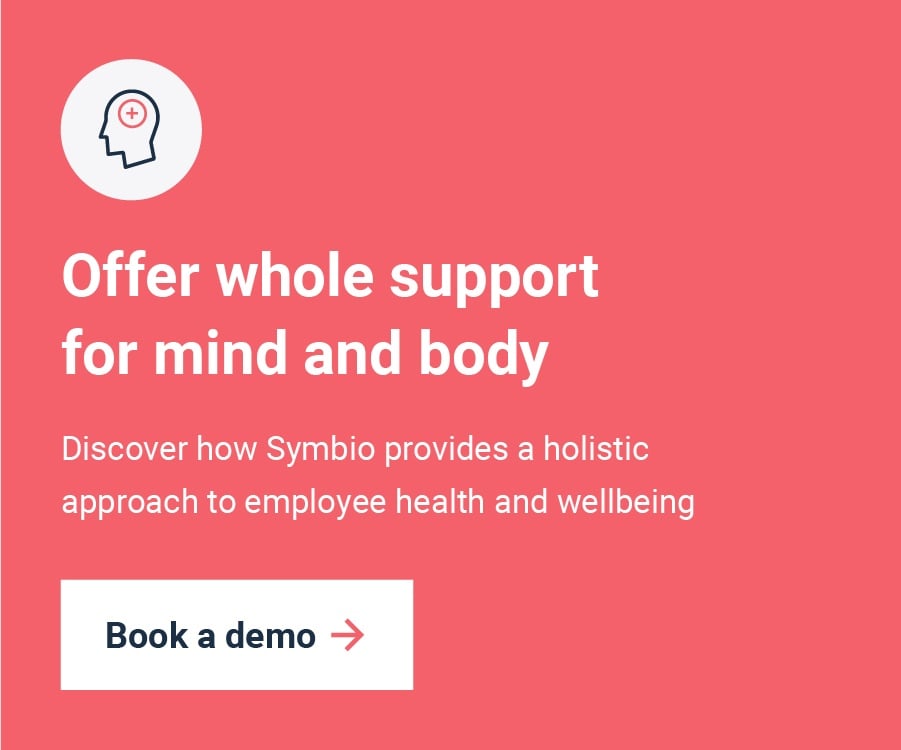Stress can cause heart attacks and strokes. People with anxiety and depression are more likely to develop weakened immune systems and cognitive disorders. The correlation between mental and physical health is well known and documented. But when it comes to employee health and wellbeing, this fact is often overlooked.
While 82 percent of employees recognise the link between good mental and physical health, only 58 percent of them agree that their employers do too. This gulf tells us that many workers are not receiving the care they need.
Why employee health and wellbeing are equally important
Physical and mental health have a symbiotic relationship. This means that it’s not only a case of mental health conditions leading to physical ailments, but also the reverse.
Take the prevalence of musculoskeletal disorders as an example. 17.8 million of the UK workforce suffer from this condition. While this is worrying, it’s worsened by the fact that those affected are twice as likely to experience anxiety or a mood disorder.
79 percent of employees agree that their mental health is no more or less important than their physical health. But when the visions of the workforce and their employers don’t align, there are serious implications:
Presenteeism
ONS statistics show that the average worker took 3.6 sick days in 2020. That’s a drop to 1.8 percent in absenteeism—and this was at the height of the pandemic.
However, just because your employees are present and accounted for doesn’t mean they’re working at full capacity. In fact, 89 percent of organisations noticed a rise in presenteeism over a 12-month period. Yet continuing to work despite suffering from a medical condition results in less productivity and an increase in human error.
The issue has become more serious with the rise of remote and hybrid working. Employees who are too unwell to commute to the office seem just fine when communicating over instant messages. So even those organisations aware of the problem will find it challenging to address it fully.
Pleasanteeism
‘Grin and bear it.’ ‘Mind over matter.’ As a culture, we encourage and applaud these attitudes. And yet they are nice ways of saying you should bottle up your true feelings.
Indeed, 51 percent of UK employees admitted to ‘putting on a brave face’ about their mental health. When you consider that only 16 percent said their mental health was very well supported at work, it’s sadly not surprising.
Leavism
A good work-life balance is crucial to employee wellbeing and health. But when 73 percent of organisations have observed some form of leavism, it’s clearly not easy to achieve.
Made possible by advances in technology and remote working, leavism is a relatively recent phenomenon. It describes the act of employees taking annual leave to either catch up on work or manage a medical condition (rather than taking sick leave).
‘The motivation for the practice is unclear, and could be a manifestation of loyalty, enjoyment or duty. It could also be construed as a reaction to fear of job loss, redundancy or downgrade.’ - Hesketh, Ivy, and Cooper, Leaveism and public sector reform: will the practice continue?
In fact, one in five workers reported feeling unable to deal with workplace stress while over half of UK employees work outside their contracted hours to complete tasks. Now that hybrid and remote working are the norm, it’s almost impossible for organisations to get an accurate representation of how much their employees are actually working. As such, burnout becomes even more likely, which in turn can have an impact on employees’ physical health.
That said, only a third of organisations plan to do something about presenteeism and its associated trends. This is despite the fact that it costs UK businesses as much as £29 billion a year. But the hard truth is that even those employers invested in their employees’ health and wellbeing face challenges when trying to address both.
No two employees are the same
One worker might only require episodic care when they fall sick or suffer an injury. Another might be managing a long-term condition like diabetes that requires ongoing support. Yet 63 percent of employees say they only get generic healthcare benefits.
Furthermore, some employees will want access to a remote GP while others prefer face-to-face appointments. And what of preventative care? Fitness programs and mental health helplines might seem wildly different, but they each help keep employees in good shape.
After all, our physical and mental health are intrinsically linked. So doesn’t it make sense that employees should have one platform to take care of both?
Where mind and body meet
There’s no shortage of employee health and wellbeing platforms. But therein lies the problem. One might support mental health while another focuses on the physical. One might provide helpful articles while another operates as a support line. While many of these applications are useful, they can get lost in the melee. And too often, they don’t integrate well together.
Symbio is the first truly holistic employee wellbeing platform for physical and mental health. It’s built for the hybrid world providing a seamless experience for all of your employees’ health needs, no matter where they are. It also integrates well with other applications, should your employees have old favourites they want to hold on to. But as a standalone platform, it offers a complete range of features and benefits:
Mental and physical
Symbio provides a one-stop-shop for total employee wellbeing with engaging advice and articles from experts, and the integrated dashboard covers both physical and mental health. It also provides access to primary care and counselling for innovative treatment of both the mind and body.
Clinical and preventative
HealthHero specialists offer episodic clinical assistance and advice while Symbio’s dynamic programs and content support employees’ self-care.
Personal
Personalised pathways cater to key employee segments providing care, content and support specific to each individual’s needs. For instance, employees can choose a pathway to help them better deal with anxiety, or improve their nutrition. There are also pathways that cater to those individuals managing long-term conditions.
Data-driven
Recognising that wellbeing is a combination of both the mental and the physical, Symbio provides a breakdown of an employee’s overall health to guide their self-improvement.
Insightful
Symbio’s predictive analytics and HRIS integration mean you gain insights into employee health across your entire organisation. This will enable you to address common issues affecting performance and productivity while improving employee wellbeing for the long term.
After all, employee health and wellbeing affect the health of your organisation too. With Symbio, you can streamline your health benefits into a holistic approach for better care, and a more productive business as a result.
-1.jpeg?width=1600&height=900&name=Untitled%20(6)-1.jpeg)

-1.jpg?width=800&height=450&name=image%20(19)-1.jpg)


%20(1)-1.jpg?width=800&height=450&name=christina-wocintechchat-com-YCrgxs3e9lY-unsplash%20(1)%20(1)-1.jpg)